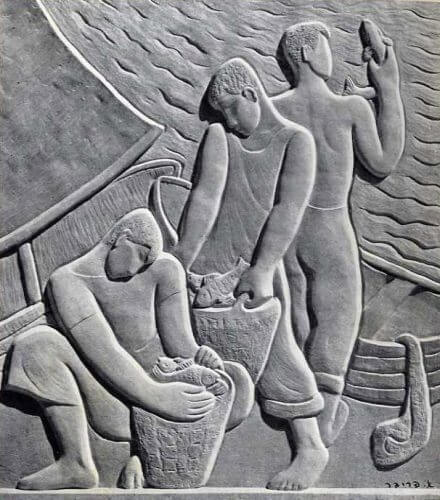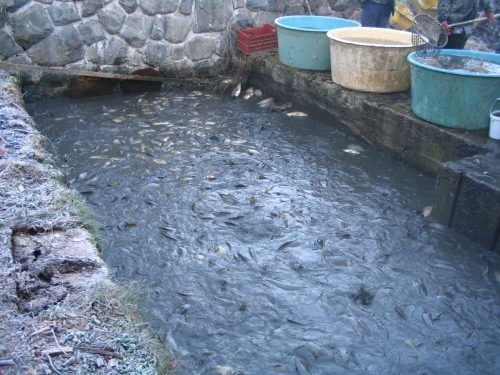Part two of a mini-series about fishing in ancient Israel

Chapter two - the fish ponds
- For the first episode in the series
- For the next episode in the series - Tiberias: the Galilean fishing capital
We will surf here and delve as much as possible into the world of fishing as it appears from the books of the Sages. And perhaps it is not fair to compare this chapter to its predecessor, as to reach a somewhat erroneous conclusion, at least on the face of it, that fishing in the Sage literature, which is filled with many facts and diverse descriptions, indicates that from the end of the Second Temple period onwards, the practice of fishing jumped much more than one level.
Let us put at your disposal, statements about their accuracy: Sage literature (Mishnah, Tosefta, Talmuds and Midrashim) suffers from a serious chronological problem due to the lack of the ability to determine chronological rivets in the light of the scriptures. It is clear to us that this literature covers a long and extended period, at least from the second century BC to the sixth century AD, and including these 800 years of history, it is impossible in most cases to decide with certainty what came before what and who came after whom. Also, the mention of figures mentioned in this literature may shed light on periods that are prior to the time of their activity, and even very early.
Certainly one should not reach any analogies regarding the very early biblical period compared to the literature of the sages on the one hand, and on the other hand it is possible to point to a certain process of biblical evidence, the evidence of Joseph ben Matthew, the evidence of the New Testament, the evidence of external literature and finally the literature of the sages.
Let's start with the halachic ruling concerning kosher matters, which prohibits certain foods, but allows the consumption of fish. A fish is allowed to be eaten provided it has scales and fins and the Nida doctrine states that "everything that has scales has a fin" (v. 9). Browsing for such and such details indicates a significant increase in fishing work following the consumption of fish.
Fishing and its products develop in the ancient Land of Israel in a considerable way for the following reasons: first - the production forces increase in the Roman provinces and within this framework we witness a Roman influence, technical and practical, with all its consequences; Second - during this period when each province becomes a large producer in the entire Roman economy, institutional bodies with economic and social influence, such as the Presidency in the Land of Israel, grow and become rich, who lend their hand in this industry and lest the Presidency be forced to supply, among other supplies, also fishing products to the emperor's court ( similar to what is known from Egypt); Thirdly - the multitude of army units and the Roman clerical system served as a respectable customer and consumer for this industry; Fourth - during this period there was an increase in the process of urbanization in the area, and in this context the city also served as an important consumer of fishing products; Fifth - during this period, the image of the farm, the villa rustica, that is, the rural, in the Roman style, developed in the Land of Israel, where special ponds were built for raising fish; Sixth - along with the development of international trade and port cities, there was a considerable technical improvement in the structure of the ship and its contents, and this had a direct effect on the quantity and quality of the produce; Seventh - following the development of industry and crafts such as weaving and weaving of nets and baskets and the development of wooden and metal instruments that are so essential to the industry in question; Eighth - the increase of the Roman exceptional taxes, such as were paid "in kind", that is, on goods, and here, on fishing products, this indirectly encouraged the fishermen to develop their branch to meet the same requirements.
One of the new signs of the Second Temple period onwards, and especially after the destruction, is the development of the subject of fish ponds. It was a certain and clear product of the spread of the villa rustica in the Land of Israel, as a clear result of the Roman rule. The term/concept "villa" in the Sage literature is "city" (and I will write an article about this in a few months) and the Tosefta enlightens our eyes on this matter by saying: "The one who sells the city. Rabbi Yehuda says: An addicted chin... and not the vibrin of an animal and of fowl and of fish" (Bava Batra 5:1). The term "bibrin" is taken from the Latin - vivarium which means a cage, a pen for storing animals, poultry and fish. Some of the corrals were used for imprisoning pets, poultry and ornamental fish, mainly in Villa Urbana (urban) and not in Villa Rustica. Recently, the captive productions were intended for consumption and/or sale. This difference is reflected in the appendix (Yom Tov XNUMX:XNUMX) which compares the captive productions that provide them with food on Yom Tov compared to those that do not provide them, and in this source President Rabbi Shimon Ben Gamaliel states that "Shochatin from the hangarin (those who are hunted immediately from the running water) and not from the citadels nor from the The trawls (we were the hunting/fishing nets)". And later on, Rabbi Shimon ben Elazar rules that "he raises his prize (the fishing net) on the evening of Yom Tov and comes and finds it as it is (without fish), for it is forbidden. It is known that we hunted (fished it) on Yom Tov."

In another text in the Jerusalem Talmud, Rabbi Yehuda emphasizes in the above context that "and biberine (fishing from the cages) is exempt (from feeding on Yom Tov)". And in another place (Talmud Yerushalmi Shabbat chapter XNUMX, hand p. XNUMX) on behalf of Rabbi Yehuda it is said that "no one hunts fish from the bibrin and does not put food in front of them." Ha to the garden and Bibrin is exempt". This text indicates the breeding of ornamental animals as common among nobles and shepherds in a different type of villas in the Villa Urbana style.
Another type of fish pond is called piscina in Latin and it appears in the Sage sources in the phrase "piskin" as it appears in the Tosefta in the language - "... and the Piskin ... are ten fathoms high" (Tosefta Irovin 2 (93) XNUMX) and in the language of the Midrash - "Piskinus". The dimensions of the pool - ten taphams, i.e. XNUMX cm - point to the classical Roman dimensions, to teach us again about the Roman influence in this regard and that the dimensions point to the development of the industry among the Jews.
In another place (Talmud Babli Shabbat line p. XNUMX) Rabbi Yehuda and the sages argue about the question of covering the biber or not covering it.
In the Golan, on the coast of Kursi, a plastered building was discovered that apparently served as a pond for storing sea fish, and it dates back to the fifth century AD (Archaeological News, 3, booklet for it, pp. 2-XNUMX). Korsi herself is mentioned in the Jerusalem Talmud in connection with Rabbi Yossi's students who immigrated from Tiberias to a place called "Karshin" (Korsi) and which was included in the Roman imperial lands.
The Roman agricultural historian Varro states that the maintenance of the ponds required the employment of many workers. The fish ponds needed a constant supply of flowing water, and for example in the vicinity of Nahal Dan or Beit Shean, where suitable stream channels were discovered and even in the birds there a complex piping system was discovered that corresponds to the description of the Jerusalem Talmud in the term "sheki".
Mendel Nun, the researcher of ancient fishing (Ancient Hebrew fishing, Kibbutz Ha'Ehud 181, p. XNUMX) is of the opinion that the phrase "metzola" refers to a fish pond, when according to the Babylonian Talmud (Brachot XNUMX, p. XNUMX) it is stated that "And my sons shall be saved Israel and Egypt. Rabbi Ammi said: He teaches that Shashua is like a mitzvah that has no grain in it, and Rish Lakish (the Tiberian aforesaid) says: Shashua is like a mitzvah that does not have fish in it. The context for a net or a trawl seems to me rather loose and more suitable for the depths of the sea, or the river (Nile).
One of the reasons for the number of fish ponds and their degree of success, in my opinion, was their refinement as a result of the intelligent use of ceramic tiles and bricks in the Galilee region.
It should be noted that all this employment of raising and nurturing fish in the ponds required a considerable investment of capital and this was afforded by well-to-do families such as the wealthy of Tiberias and Tiberias on the one hand or associations of several families and perhaps also, as we will prove later, among professional associations.
